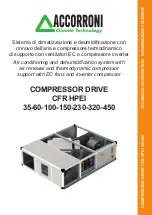
sounds to be unaffected while solo and very loud sounds are compressed. (Of course, when
compression occurs, the level of the entire program is affected - however, if the 166xs
CONTOUR button is pressed in, even more of the signal’s lower energy can be preserved.)
Depending on the THRESHOLD setting, lower amplitude fundamentals or harmonics will not
cause compression, and the program is not subject to the phase shift normally caused by
program equalization.
166xs
OUTPUT
INPUT OUTPUT
SIDECHAIN
INSERT
EQ
SOURCE
Figure 4: Frequency-Weighted Compression
When recording cymbals and tom-toms, a compressor with an equalizer in the Sidechain path
can help prevent analog tape saturation. The equalizer can be adjusted for boost with a peak
of about 5kHz, causing the cymbal to be compressed on a very loud crash, stopping tape
saturation at high frequencies, where there is less headroom. However, gentle tapping
of a drumstick or brushing of the cymbal will not be affected. Assuming the tom-tom is a
lower frequency instrument and can be better tolerated by the tape, it has less need for
compression. Equalization in the Sidechain circuit means that the compressor is not triggered
as readily by a loud tom-tom beat as by an equally loud cymbal crash.
The converse of the above EQ technique may be used: dipping the equalizer bands causes any
sound with dominant energy in the affected register to pull the level up because the 166xs
will detect a need for less compression.
De-Essing
To apply de-essing to vocals (i.e., a reduction of sibilance), use a parametric equalizer in the
SIDECHAIN circuit and set it to boost the specific frequency range where the vocal “hiss” or
lisp occurs (generally in the 4kHz - 6kHz region). This pre-emphasizes the already “hissy”
vocal input to the Sidechain. Used in conjunction with a moderate to high THRESHOLD and
RATIO, and a fast Attack and Release setting, this arrangement greatly attenuates the
“essing” without affecting the basic sound quality or balance of the voice. While it is true
that all frequencies are lowered in level when the compressor is triggered, generally the “sss”
sound occurs alone, before or after the dominant tone in the voice.
Increasing Sustain
To increase the sustain of a musical instrument (e.g., a guitar or bass), use an equalizer in the
Sidechain circuit and boost the EQ in the dominant frequency range of the instrument. Set the
166xs for slow Hard Knee compression, with a fairly low THRESHOLD and a moderate RATIO.
Multi-Way Speaker Systems
If a single compressor is to be used with a multi-way speaker system (i.e., before the
crossover, after the EQ), the system operator is faced with the problem of keeping levels below
the point of damage of the most sensitive part of the system. If, for example, mid-range
Section 4
Operating Notes
19
dbx 166xs






































